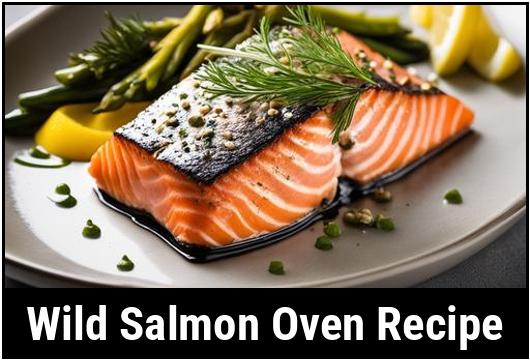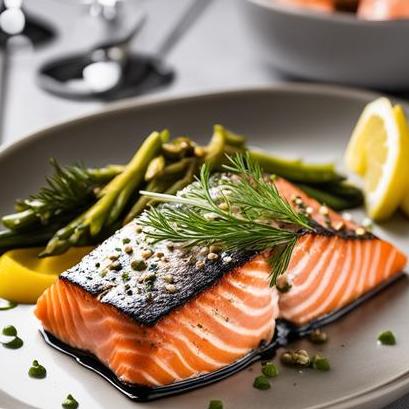
A Comprehensive Guide To The Perfect Wild Salmon Oven Recipe
If you’re a seafood lover, there’s nothing quite as delightful as a perfectly cooked wild salmon. The tender and flavorful flesh of this majestic fish is not only a treat for the taste buds but also a nutritional powerhouse. In this comprehensive guide, we will take you on a journey through the world of wild salmon oven recipes. From understanding the food science behind cooking salmon to the finest culinary details, this article leaves no stone unturned.
Understanding the Food Science
When it comes to cooking wild salmon, understanding the food science is crucial to achieve the perfect result. Salmon is a delicate fish with a high fat content, which contributes to its rich flavor and buttery texture. However, this fat also makes salmon prone to drying out during cooking if not handled properly.
The Maillard Reaction and Flavor Development
One of the key aspects of cooking salmon is harnessing the Maillard reaction. This chemical reaction occurs when proteins and sugars in the fish’s surface react to heat, resulting in browning and the development of complex flavors. By achieving a beautiful crust on the surface of the salmon, you’ll enhance the taste and visual appeal of the dish.
Temperature Control and Doneness
To ensure your wild salmon is cooked to perfection, it’s vital to understand the concept of doneness. The desired level of doneness can vary depending on personal preference, but it’s generally recommended to cook salmon to medium-rare or medium to retain its delicate texture and prevent dryness. To achieve this, you’ll need to monitor the internal temperature of the fish.
Culinary Details: Selecting the Perfect Wild Salmon
Before diving into the cooking process, let’s explore how to select the ideal wild salmon for your oven recipe. To truly bring out the flavors and enjoy the best texture, quality is key.
Freshness and Seasonality
Freshness is paramount when choosing wild salmon. Look for shiny, firm flesh with a vibrant color. Avoid fish with any strong fishy odor, as this is a sign of less than optimal freshness. Additionally, consider the seasonality of the salmon. Each type of wild salmon has its own peak season, when it’s most abundant and flavorful.
Types of Wild Salmon
There are several varieties of wild salmon, each offering its own unique flavor profile. Some of the most popular types include:
-
Chinook (King) Salmon: Known for its rich, buttery flavor and high oil content, Chinook salmon is considered a true delicacy.
-
Sockeye (Red) Salmon: Recognizable by its vibrant red flesh, Sockeye salmon has a robust flavor that is slightly more intense than other varieties.
-
Coho (Silver) Salmon: Coho salmon boasts a milder flavor compared to other types, making it suitable for a wide range of recipes.
-
Pink Salmon: Pink salmon, with its light and delicate flesh, is an excellent choice for those seeking a more subtle and delicate taste.
Cleaning and Preparation

Once you’ve chosen your fresh wild salmon, it’s time to prepare it for the oven. Proper cleaning and preparation ensure the fish is ready to absorb the flavors and cook evenly.
Cleaning the Salmon
Start by rinsing the salmon fillets under cold running water to remove any impurities and slime. Pat them dry with a paper towel, being careful not to remove any of the natural oils that add to the salmon’s rich flavor.
Removing Pin Bones
Run your fingers along the flesh to detect any pin bones. Use a pair of clean tweezers or salmon bone pliers to gently pull out these tiny bones. Ensuring the fillets are free from pin bones enhances the eating experience.
Seasoning and Marinating
Before cooking, consider seasoning and marinating the salmon to elevate its flavor profile. A simple mix of salt, pepper, and fresh herbs can work wonders. Alternatively, you can experiment with various marinades using ingredients like citrus juices, soy sauce, or honey.
Tips for Cooking Wild Salmon in the Oven
Cooking wild salmon to perfection requires attention to detail. Below are some valuable tips to achieve the best results:
Preheating the Oven
To ensure even cooking, preheat your oven to the desired temperature before placing the salmon inside. This allows for consistent heat distribution and helps to develop an appealing crust.
Choosing the Right Cooking Method
While this guide focuses on oven cooking, several other methods can be used to prepare wild salmon. Grilling, pan-searing, and poaching are all effective techniques. However, oven cooking is particularly forgiving and offers excellent control over the final result.
Optimal Oven Temperature
For most wild salmon oven recipes, a temperature range of 375°F to 425°F (190°C to 220°C) is recommended. This temperature range allows for precise control over doneness while promoting the Maillard reaction for added flavor.
Using Parchment Paper or Aluminum Foil
To prevent the salmon from sticking to the baking dish or sheet, line it with parchment paper or aluminum foil. This also aids in easier cleanup.
Monitoring Internal Temperature
Investing in a reliable instant-read thermometer is worth considering. By inserting the thermometer into the thickest part of the fillet, you can ensure the salmon reaches the desired doneness. Target an internal temperature of 125°F to 130°F (52°C to 54°C) for medium-rare, or 135°F to 140°F (57°C to 60°C) for medium.
Recipe: Oven-Baked Wild Salmon with Lemon and Herb Crust

Now that you’re well-equipped with the knowledge and techniques, let’s dive into a delicious recipe for oven-baked wild salmon with a lemon and herb crust.
Ingredients:
-
2 pounds (900g) wild salmon fillets
-
2 lemons, sliced
-
1 bunch of fresh dill
-
4 tablespoons (60g) unsalted butter, melted
-
Salt and pepper to taste
Instructions:
-
Preheat your oven to 400°F (200°C).
-
Line a baking dish with parchment paper or aluminum foil.
-
Place the salmon fillets skin side down on the prepared baking dish.
-
Season the fillets with salt and pepper to taste.
-
Drizzle the melted butter evenly over the salmon.
-
Arrange the lemon slices and fresh dill sprigs on top of the fillets.
-
Place the baking dish in the preheated oven and bake for approximately 12-15 minutes or until the salmon reaches your desired level of doneness.
-
Remove the salmon from the oven and let it rest for a few minutes before serving.
Variations and Personalization
While the above recipe provides a delicious foundation, feel free to personalize it with your favorite flavors and ingredients. Here are a few variations to consider:
-
Honey Glazed Salmon: Create a sticky and sweet glaze using a combination of honey, soy sauce, and minced garlic. Apply the glaze over the seasoned salmon before baking for a delightful twist.
-
Citrus Zest and Herb Crust: Experiment with a blend of citrus zest, including lemon, lime, and orange, combined with finely chopped fresh herbs like parsley or basil.
-
Spicy Cajun Rub: If you’re a fan of bold and spicy flavors, coat the salmon liberally with a homemade Cajun seasoning blend before baking. Adjust the heat level according to your taste preferences.
Final Thoughts
Cooking wild salmon in the oven is a delightful culinary adventure that rewards with its melt-in-your-mouth texture and rich flavor. Armed with the knowledge presented in this comprehensive guide, you are well-suited to create the perfect salmon dish, tailored to your preferences. Remember to pay attention to the food science, select the best ingredients, and experiment with variations to make your wild salmon oven recipes truly exceptional. Enjoy!



